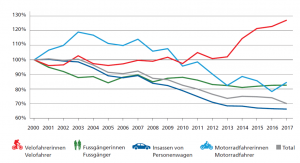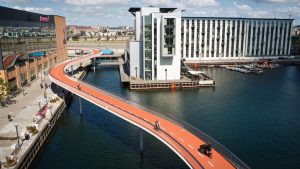Julia Timcke
Dangerous tram tracks, abruptly ending cycle paths and trucks driving too close – anyone travelling by bicycle in Zurich is familiar with these situations. The bicycle network in Swiss cities is a hotchpotch, which prevents many people from making daily commuter trips by bicycle. Why is cycling in many countries still not a safe alternative and what is needed on a global scale to promote the two-wheeled mode of transport with all its benefits?
Why cycling needs to be promoted in cities
The urban population in developed nations is growing rapidly. By 2050, it is expected that around 2.5 billion people will be added to the world’s population and around halve of it will live in cities. One of the most important steps in managing the inevitable rapid urbanisation is to meet the needs of residents for services and mobility, while promoting also equity and addressing environmental issues. Problems of sustainability in urban transport are daily business in developed countries. To tackle them, many implemented public policies try to promote besides public transport non-motorized commuting modes.
The bicycle has long been known to be one of the most environmentally friendly means of transport. Especially in cities it seems to be becoming more and more popular as a method of commuting to work as it is flexible, low in acquisition and usage costs and can bypass any traffic jam. Furthermore, it enhances urban quality and facilitates social cohesion among citizens. All those goals go along with the SDGs aiming for sustainable cities, reduced inequalities, climate action and health and wellbeing. 1
Are Swiss cities a cycling nightmare?
If you look at the Copenhagenize Index, one of the most comprehensive and holistic ranking of bicycle-friendly cities of the world, you search in vain for a Swiss city in the top 20. Among the first few places rank Northern European cities such as Copenhagen, Amsterdam and Utrecht. There is still a lot of unfulfilled potential when it comes to Switzerland’s use of the two-wheeled mode of transport. A study on mobility from 2010 carried out in six German-speaking cities in Switzerland showed, that in Zürich only 6% of people travel by bike, whereas in Bern the number of cyclists was 11% and in Basel even 16%. Even though Swiss cities are much more mountainous compared to cycling city forerunners of other countries, the demand for a better infrastructure is great.
The City of Zürich has a developed a masterplan aiming to increase the share of bicycle traffic in total traffic and doubling the frequencies in the period 2012 to 2025. This should be achieved by many new cycling routes connecting the agglomeration along the lake of Zürich to the city and with a project called “Velo sicuro”. This project comprises three fields of action: Bicycle accident hot spots, bicycle route check and assessment of construction projects. The overall objective of “Velo sicuro” is to prevent a further increase in the number of accidents or even reduce the number of bicycle accidents by means of improvements to the infrastructure. 2
A major step on a national level was taken in 2018 with the Federal Government’s Bicycle Decree, which is a direct counterproposal to the ProVelo Bicycle Initiative. The aim of the initiative was to encourage cycling by improving the infrastructure and addressing the large deficits in the area of non-motorized traffic. The wish of the initiative to include cycling in an article of the federal constitution that recognises already the governments duties concerning the maintenance of footpaths and trails was rejected by the counterproposal. The Federal Government’s Bicycle Decree gives the Confederation the opportunity to define principles for cycle route networks and to support and coordinate measures by the cantons, municipalities and other players. This is pleasing not only from the point of view of environmental friendliness and the promoted mobility, but also because of the increased safety. The number of cyclists killed and injured in accidents has increased since 2000 by over 27%. Wherever there are continuous cycle paths and traffic is diverted, there is less congestion for cars, bicycles and pedestrians. This helps to increase traffic safety. 3

Figure 80.1 – Number of cyclists injured or killed in accidents (red) compared to other modes of transport. Source: UVEK 3
What is needed to become a cyclable city
In order to keep up with the spirit of the times and respond to the future increase in urbanisation and the demand for reduced emissions, new solutions are needed which relieve the burden on motorised traffic in conurbations and are less space intensive.
When you look at the world’s number one cycling city, Copenhagen, it quickly becomes clear that a prior improvement of the infrastructure is needed to encourage people to use the bicycle more often. There needs to be an even denser network of safe, connected cycle paths such as bicycle highways (see figure 2) as well as more dedicated spaces to lock up the two-wheelers in order to change the leisure and commuting habitats of the citizens.

Figure 80.2 – The newly built bicycle expressway in Copenhagen. Source: ZHAW Institute of Sustainable Development 4
Compared to normal cycle routes, bicycle highways are wider and very straightforward without crossing other roads. They aim to integrate bikes into the overall traffic concept of cities and agglomerations by supporting commuter flows of everyday traffic from the nearby regions. Such highways need to be coordinated well with the already existing cycle routes in the region and connect to the inner-city cycle traffic network for a good traffic flow and distribution to working areas. As they are rather expensive to implement, especially in limited urban areas, cities need to be very aware of the use of existing cycle paths and work routes, so they spend their money on long-term beneficial projects. A good example for such a process is Lucerne, which reacted to the fast-growing suburbs and their desire of a fast and direct connection to the centre with an almost two-kilometre-long cycle and footpath connection. This new “highway” was built on the newly cleared track of an old train connection. Other Swiss cities like Winterthur, Burgdorf, Chur, Bern and St.Gallen are in a test phase for similar projects.4
Also beneficial for bicycle traffic in cities are Urban Mobility Hubs which are located outside the conurbations and offer commuters better links to public transport. In such a mobility center, cars would stay outside the cities and offer footpaths and cycling roads much more space and a safer environment. Another great innovation are bike-sharing systems, which have been proven to be highly successful in helping to promote cycling as a viable and valued transport option in cities. The institute for Transportation and Development Policy reports in its bikeshare planning guide that worldwide already more than 600 cities own a bike-share system, where the largest are in Chinese cities. About two years ago, Publibike launched its network in Zurich and experiences ever since a growing demand. Today there are already over 120 stations in Zurich with over 1400 bikes and e-bikes. Nevertheless, linking systems and connecting sharing services to public transport remains a challenge, which would make sharing offers even more popular. 5
Despite their importance, safety and comfort issues are not the main barriers preventing people to commute by bike although more progress needs to be done to normalise it. As shown in a study from 2016, a set of customised policy initiatives is recommended. In the light of the research findings, a number of tailor-made policy initiatives are recommended, including marketing campaigns to promote non-commuting cycling tours, cycling measures aimed at social groups rather than individuals, bicycle-specific programmes such as “bike to work” days and bike lessons. 6
References
1 Cycling, the better mode of transport. UN Environment 2019. (https://www.unenvironment.org/news-and-stories/story/cycling-better-mode-transport, visited on 03.05.20)
2 Stadtverkehr 2025 Zürich (https://www.stadt-zuerich.ch/ted/de/index/stadtverkehr2025/masterplan_velo_gegenvorschlag.html, visited on 03.05.20)
3 Bundesbeschluss über die Velowege sowie die Fuss- und Wanderwege, 2018,(https://www.uvek.admin.ch/uvek/de/home/uvek/abstimmungen/velo-vorlage.html, visited on 03.05.20)
4 ZHAW Institute of Sustainable Development (https://www.zhaw.ch/en/engineering/institutes-centres/ine/smart-city-guide-main-page/description-of-applications/bicycle-highway/, visited on 03.05.20)
5 Cycling, the better mode of transport. UN Environment 2019. (https://www.unenvironment.org/news-and-stories/story/cycling-better-mode-transport, visited on 03.05.20)
6 Transition to a cyclable city: Latent variables affecting bicycle commuting 2016 (https://www.sciencedirect.com/science/article/abs/pii/S0965856415002566, visited on 03.05.20)